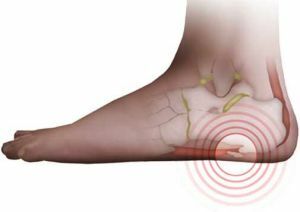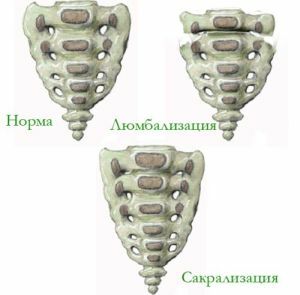 A large number of diseases are affected by the human body. The disease can damage internal organs, skin and bones.
A large number of diseases are affected by the human body. The disease can damage internal organs, skin and bones.
Such an ailment that causes great trouble to people is the Brody abscess. It occurs rarely, but it is worth knowing about it.
Contents of the article
- What is this
- What is it?
- Causes of the disease
- Clinical picture
- Diagnosis in a medical institution
- Radiography
- Differential diagnosis
- Treatment methods
- As a summary
What is an
? The disease is a form of osteomyelitis of the hematogenous. Inflammation is localized in the epimetaphyseal part of the long tubular bones. Most often, it is the epiphysis of the tibia and the distal epiphysis of the radius.
The disease is most common in adolescents and males.
Infectious agent - a strain of staphylococcus. Foci of damage are single. Their magnitude, as well as the shape depend on the duration of the disease:
- In the early stage of the , they are oblong, similar to a droplet. They reach a size of one and a half to two centimeters.
- For a long term disease, their shape becomes globular, the diameter reaches five centimeters.
The clinical feature of Brody's abscess is a prolonged course. The process can last several decades.
Causes of the disease
Focal bacterial infection. Most often, staphylococcal. The body weakens, immunity decreases. He can no longer fight with ailments and they begin to "attack" him. Usually, Brody's abscess is preceded by osteomyelitis.
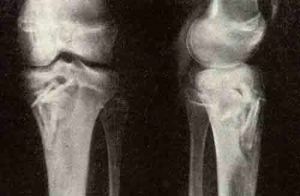
Abscess of Brod on X-ray
Paths of penetration of microbes into the body:
- damage to the skin;
- accumulation of large amounts of blood;
- cyst;
- boils;
- infections are purulent.
Chemical substances penetration under the skin with:
- introduction of highly concentrated drugs;
- by subcutaneous injections and droppers.
It should be added that penetration can occur only if aseptic rules are not followed. There were cases when, twenty years after the onset of the disease, virulent bacteria were found in the purulent discharge.
Clinical picture
Symptoms of the disease may be different. The first thing to pay attention to is that when pressing on the hearth, there is a limited sensitivity.
At night, with severe physical exertion, painful sensations appear.
The first sign of the disease is:
- the presence of a solid node;
- swelling and redness around it.
In the future, after a few days, and even weeks, a capsule filled with pus appears.
download. ..The disease can for years disturb the person, giving him a little respite.
The resulting exacerbation is sometimes accompanied by:
- temperature increase;
- weakness;
- malaise;
- reddening of the skin around the inflamed area;
- pain when pressing.
Visual examination by a specialist does not give a complete picture of the disease.
Diagnosis in a medical institution
Consists of two stages.
Radiography
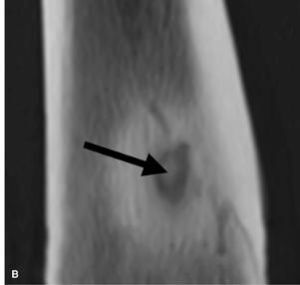 Diagnosis of the abscess Brody with X-ray. It is this method that is decisive in determining the disease and the purpose of treatment.
Diagnosis of the abscess Brody with X-ray. It is this method that is decisive in determining the disease and the purpose of treatment. In the pictures obtained during the procedure, the specialist sees that a cavity appeared in the spongy part of the tibia. Its diameter ranges from two to two and a half centimeters and is surrounded by a zone of sclerosis.
The cavity itself is filled with pus, serous or bloody fluid. With a more thorough viewing, you can see it as a tissue detritus.
Differential diagnosis
It is necessary to exclude or confirm the presence of such diseases as:
- osteoid osteoma;
- tuberculous ostitis;
- is an eosinophilic granuloma.
It is often believed that this disease is joint. Only, using differential X-ray diagnostics, it is possible to refute this opinion. On radiographs it is seen that the metaphyseal parts of bones are covered with inflammation.
Having performed two stages of diagnosis, having obtained the necessary results, it can be stated that the patient is most likely Brody's abscess.
Methods of treatment
At the initial stage of the disease, a conservative method is used:
- The limb is impregnated with gypsum for three to four weeks. Thus, the damaged area is fixed.
- Intramuscularly administered antibiotics.
- In case of exacerbation of the disease, anti-inflammatory X-ray therapy is performed, sometimes scraping out the focus and introducing penicillin into its cavity.
- Physiotherapy is prescribed, most often UHF.
- General restorative treatment.
- High-calorie food.
- Peace.
In case the conservative method does not yield positive results, the second method is used - surgical intervention.
Completely removes the damaged part of the bone. After a while, it is replaced with a graft.
During the operation, the cavity is fluttered, the inner wall is scraped, the wound is sutured.
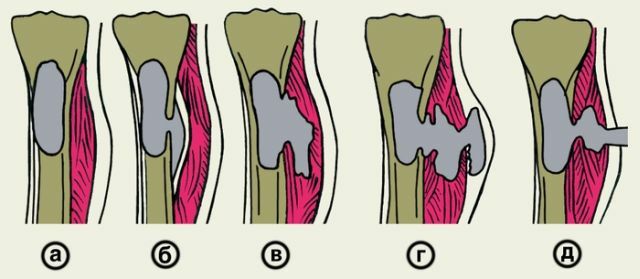
Fistula formation process
Sometimes self-healing occurs. This process is very painful, pus breaks into soft tissue, a fistula is formed.
As a summary of
Based on all of the above, we can conclude: Brody's abscess is a rather dangerous bone disease. Teenagers and young people under the age of twenty-five, most often male, are exposed to him.
There are no symptoms at the onset of the disease.
The clinical feature is a prolonged course. Often it drags on for three decades. The correct diagnosis can be made only with the help of an X-ray. There are two methods of treatment that can be used in a complex: conservative and surgical intervention.
download. ..

